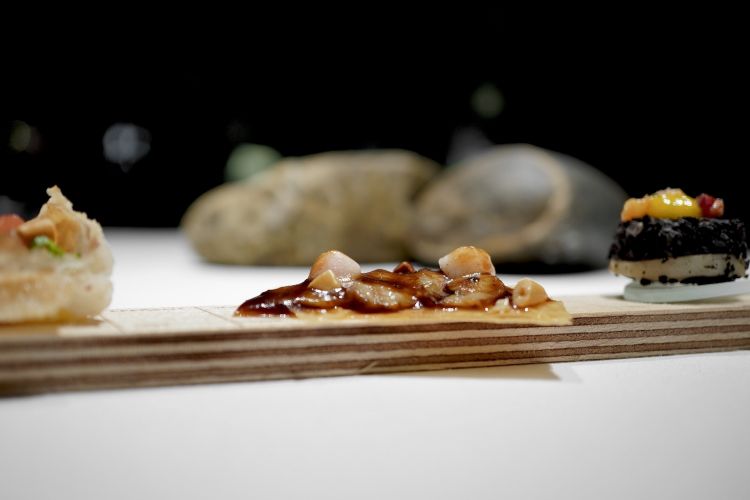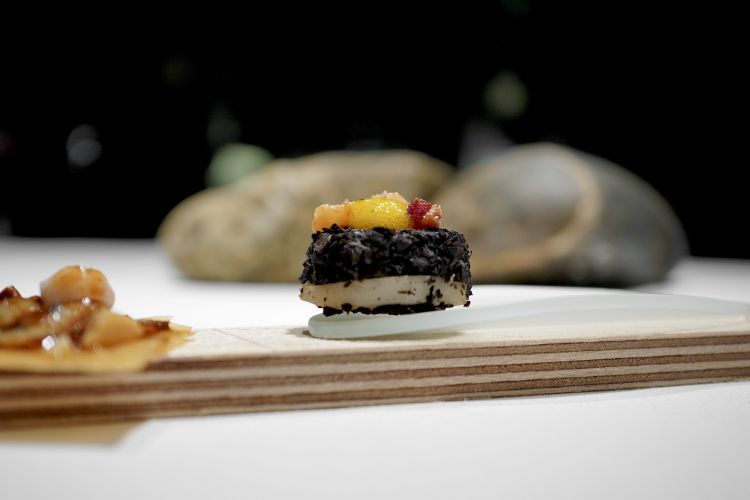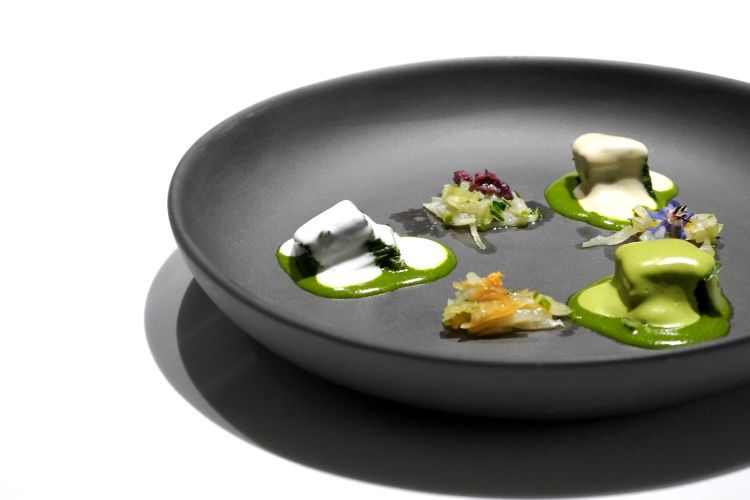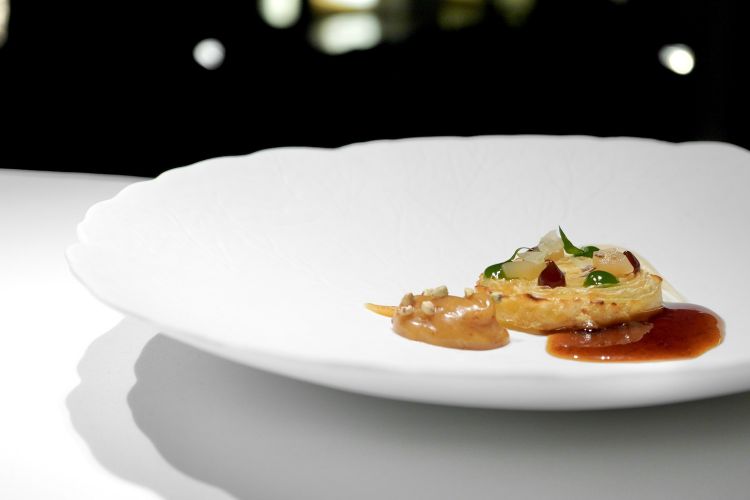For once it would be enough to taste the appetizers alone, and then you could just as well leave the table to get a precise idea (because they are deep and complete mini-dishes that trace the history of the restaurant without being just explanatory, there’s no celebratory-effect nor is there a boring “how-we-were” approach: instead, they are direct, precise, current, imaginative, full, excellent).
Or we could do the opposite, turn the rules upside down and start from the end, and stop there: in other words, just taste the desserts and discover that creativity has never been missing here, and continues to press especially on the D (dessert) side of the meal, the most difficult frontier, where the “D” also stands for disappointment, in fine dining (not here: the desserts are both delicious and inclusive, as well as aesthetically perfect – not in the French style, but following the idea of recovering what makes us go back to our childhood, as if we were in front of a birthday cake from the past -, technically superlative, conceptually illustrious. Delicious. And there’s also that recipe of which we recently talked here, the Bosque lluvioso, ohhhh what a marvel deserving of applause).
So El Celler de Can Roca is certainly a great maison, a fine dining place that has been established for decades. Famous around the world, it has become iconic and has the strength of being able just to present itself as the alfa and omega. In other words, it is capable of playing/surprising with hints that can be even self-centred, because they are credible, and authoritative; all this in a magnificent dining room, with just a hint of retouching after the recent restyling because it was already perfect, full of contemporary elegance and relaxing, while the kitchen was completely renovated and is incredible, huge, very well organised, as you would expect from a place like this.
El Celler de Can Roca however is not just a great maison. Of course, the
Rocas are fully and rightly proud of their history and their accomplishments, and this is clear by the largest menu, called
Festival and for us they have further strengthened it, reaching 32 tastings. Remarkable. What’s surprising is the coherence and the current character of the menu that joins new dishes with others that date back as far as 1989. The first part of the menu is mostly focused on this trip in time, a bombardment of appetizers that cover decades, a sort of summary of an epopee of taste, but in bonsai-size.
But there’s also the capacity of staying current: Olivada, from 2018, has a retro charm (the spherification of olives is now a classic) but lots of that overpowering strength that generates emotion for palate and mind. It’s a masterpiece, in other words. The same goes for Mar y montaña vegetal, a dish from this year. Or Grifola frondosa with chestnuts.

Lenguado a la brasa con sabores mediterráneos
And the astonishing
Lamb and couscous, five takes on lamb with as many sides of fake couscous, which reminded me of another historic recipe from
Celler, which we tasted many years ago, and is still printed in my memory among the best of all times, the
Lenguado a la brasa con sabores mediterráneos, a sole that is simply grilled, served with five sauces – fennel, bergamot, orange, pine nuts and olives – an emblem of simplicity of excellence, in which every taste shows a different harmony, always incredible and charming. Here, with the lamb, the standards are more or less the same.
So, as we said, there are the right hints at their history, at their historicised reality. But Celler pushes further, especially with the desserts, where the three brothers – thanks to Jordi, the youngest’s talent – take a new challenge. It’s perhaps the most intriguing part, in perspective.
And now we explain our dinner, in our case presented step by step by a talented Italian who has been working for 4 years at Celler, Genoese Nicolò Tumminello. The photos are from Tanio Liotta.

The debut of the long journey is itself a journey in five tastings "in sequence", each one representing a step in the history of Celler. We start with a "bonsai" version of the dish that celebrates 1986, when they opened the restaurant, and which was renewed in 2001, Chicken cannellone with foie gras, truffle and Parmigiano

1997, restyling of the first restaurant: Carpaccio of pork feet on perol brittle with white Garroxa beans, pine nuts, tomatoes, chives (the mini version is a new take on the original from 1989). Perol is a sort of pork stew typical of Catalonia

1998, Jordi Roca arrives at Celler: Tartelette of porcini with miso, veal bone marrow and pine nuts. The dish is from 2013

In 2007 Celler moved to the new (and current) location: Mousse of truffle on a disc of Jerusalem artichoke, egg yolk and smoked pancetta

2020, the restyling after the pandemic: Buñuelo of blue lobster with coriander and hot sauce

Escudella in the wood oven, vegetable aspic and pickles. Escudella is a great Catalan classic, once again a juicy stew with meat and vegetables. Here it’s in two versions: left, as a broth, right as an aspic of escudella with black truffle. From 2021

Elegance, finesse, harmony: Cream of raw cow’s milk from Formatgeria La Xiquella with gel of veal, truffle and “vegetal caviar” of chia seeds (2021)

Truffle brioche. A simple name, a blast of flavour. From 2009

Now a trilogy of the Mediterranean region, simply perfect. The first tasting is one of the most famous, but also the less interesting, Toda la gamba (2012): an entire red prawn from Palamós – the body is lightly marinated in rice vinegar, there’s a velouté made with the carapace and a reduction of bisque. The legs are both fried and lyophilised. Finally, there’s caviar with lemon

A marvellous, delicious, extraordinary, super-dish: Olivada, micro-spheres of olives of different cultivars (Aloreña, Cordobesa, Verdial, Kalamata, Cornicabra). On the base, a sorbet of Arbequina olives, then a sheet of Gordal olive and finally piparra, Basque sweet chilli (2018)

Another dish from 2018: Preserved vegetables with romesco sauce, tabasco and finger lime. The vegetables are endive, flowers of blackberries, oxalis flowers, mauve buds, jicama (Mexican potato). A hint at Italian caponata

2012: Kale cabbage with anchovy sauce and truffle. There are different textures of cabbage (savoy, kale, braised Brussels sprouts...) with anchovy mayonnaise, reduction of veal broth and truffle

Navajas and calçots. The latter are from the onion family, delicate, very popular in Catalonia. Navajas are more or less like our squilla mantis, even though they belong to a different type of bivalve mollusc (the former are Ensis siliqua, the latter Solen marginatus). But it’s similar. The dish shows different textures of calçots and navajas with oil of seaweeds, Pedro Ximénez balsamic vinegar, black sesame and lemon. 2020

2001: Velouté of crustaceans and seafood, with celery, tomato and caviar

A sort of surf and turf from 2012: Oyster with Palo Cortado, game sauce and truffle. The Gillardeau oyster is cooked in game jus and Palo Cortado sherry and paired with an emulsion of Bearnaise sauce and truffle

2005, the first dish that is completely the result of two creativities joined together, that of Joan and Jordi Roca, hence sweet and savoury: Torroncino of foie gras, cocoa, truffle, reduction of Pedro Ximénez and hazelnut

Three types of bread, each one made to represent a different Roca brother: classic bread for Joan, bread with a dough of red wine and raisins for Josep, bread with tomato for Jordi

We start with the dishes from 2022. First another surf and turf, this time vegetal: Mar y montaña vegetal, that is to say mousse of plankton, cream of pumpkin seeds, basil oil, sprouts of aromatic herbs with seaweeds (and more: there’s salicornia, sea fennel and fennel), enoki mushrooms and honey. Impressive

Another dish: they steam the lágrima peas with a steam of Xare-lo wine... The lágrima peas are called "green caviar" and they are very expensive peas (350 euros per kilo) and are grown in the Basque country. Sweet, savoury, crispy, with a strong and herbaceous flavour. Spanish chefs are crazy about them. The wines from Xare-lo grapes – also used for Cava – are fresh, citrusy and with a slightly vegetal finish

Lágrima peas steamed with Xare-lo. On the base, an emulsion made with the pods, a pesto of pistachios with toasted pistachios, wasabi from Montseny with its oil, and yuzu

Beets. The dish is made of beets in different textures, there are some small millefeuilles (the first is the white one on the left, with an emulsion of jamón iberico fat; the second, yellow, is glazed with a sort of bagna cauda; the third, green, mixes the previous elements, hence beets, anchovy and jamón). The recipe also includes different juliennes made with the stalk of the beet: marinated in Amontillado di Jerez (a sherry), paired with a tartare of black olive, with an emulsion of saffron, zest of grapefruit and borage flower

Grifola frondosa with chestnut. Grifola frondosa is oyster mushroom (it grows near chestnut trees), served with a consommé of roasted onion and cloves, chargrilled chestnut with pine oil, yuzu cream and notes of orange, grapefruit and lime zest, soya sauce and champignon mushrooms. Great harmony

Celeriac and pear. The millefeuille of celeriac is stuffed with a pear compote, drops of coffee, tarragon, anise and preserved rhubarb. It is paired with a purée of smoked celeriac and toffee of caramelised cream with buckwheat. On the base, a reduction of chargrilled celeriac peel

Tartare of beetroot: in the centre a “steak tartare” of beetroot with mustard, Worcester sauce, tabasco, chives. Then carpaccio of preserved beetroot; milk of pecan nuts; chutney of yellow turnip; hollandaise sauce with beetroot; smoked and fermented beetroot; tartare of leaves and sprouts. A very interesting dish

Heart of artichoke confit, artichoke vermouth sauce, artichoke chips, mustard and hazelnut butter

Salad of sea urchin in escabece, with an oil of codium seaweed, with coriander gel on the base, then smoked yogurt, aioli with saffron, caviar of aubergine preserved in vinegar, cantaloupe melon, sweet potato, red seaweed, gel of vinegar and e bottarga

Chargrilled scampi with cream of artemisia, vanilla oil, foam of noisette butter

Turbot trilogy: from the bottom, anti-clockwise, carpaccio of marinated turbot with tartare of Kalamata olive, chives, zest of grapefruit and dried tomato; turbot filet with pil pil; grilled turbot with cream of garlic and oxalis flowers

Lamb and couscous: lamb, excellent, in five different interpretations, and as many types of vegetal couscous. Smoked filet of lamb with fake couscous of cucumber and pepper; crispy belly with fake couscous of green apple, tarragon and cinnamon; fried brain with sauce of sheep’s milk with fake couscous of cauliflower; glazed sweetbreads with capers and Jerez vinegar, fake couscous of celeriac, mint and parsley; ragù of lamb neck with fake couscous of celery, cardamom, and basil

Pithivier stuffed with Bresse chicken, foie gras, truffle and herb sauce

Bosque lluvioso: gelato of horn of plenty with pinecone honey, earth from the horn of plenty and pinecone, crispy leaves of cocoa and powdered pinecone, distilled earth

Bola de colores: a sphere of candy floss, with different colourful and frozen shots (fennel, basil, red fruits, litchi, caramelised apple, green apple, citrus fruits, passion fruit, coconut, blackcurrant, apricot, mint...). Underneath, a custard aromatised with rose petals

Vaniglia in different textures served with raisins, crispy tobacco leaves, green orange, walnut praline, biscuit with spices, gelato of hazelnut butter